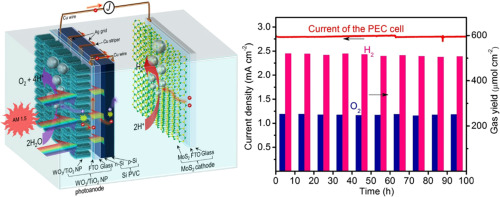Nano Energy ( IF 17.6 ) Pub Date : 2017-09-21 , DOI: 10.1016/j.nanoen.2017.09.032 Qingyi Zeng , Jing Bai , Jinhua Li , Baoxue Zhou , Yugang Sun

|
The stability and cost of solar-driven water splitting system are still the main bottlenecks for its large-scale implementation. Here, an ingeniously designed low-cost photoelectrochemical tandem cell possessing three performance-superior components, i.e., a front novel photoanode of WO3 nanoplates epitaxially coated with [001]-oriented TiO2 nanoprickles, and a rear Si photovoltaic cell, and a counter-cathode of interlayer-expanded MoS2 nanostructures, is reported for highly-stable and efficient solar water splitting. The tandem cell shows a close-to-unity Coulomb efficiency for water splitting, and a high and sustained-stable solar-to-hydrogen efficiency in a 35 days’ test. The result also reveals that it is versatile in solar-driven wastewater treatment. Most importantly, the composite photoanode that, for the first time, is proposed using epitaxial-growth based on double-match, i.e. lattice match and band match, shows dramatical improvement in stability and photoelectrochemical performance, in which the photocurrent of the WO3/ TiO2 photoanode is improved by 80% without any obvious decay after 100 h of continuous testing compared with a 92% decay in photocurrent for the WO3 photoanode. The epitaxial TiO2 layer facilitates interfacial charge transportations and provides a complete sealing of WO3 surfaces at an atomic level. Such efficient interfacial design and system-level integration of high-performance nanomaterials shed a unique light on the potential large-scale implementation of solar water splitting for renewable hydrogen fuel production.
中文翻译:

低成本的光电化学串联电池,用于高度稳定和高效的太阳能水分解
太阳能驱动的水分解系统的稳定性和成本仍然是其大规模实施的主要瓶颈。在这里,一个经过精心设计的低成本光电化学串联电池,具有三个性能优越的组件,即外延涂覆有[001]取向TiO 2纳米晶核的WO 3纳米板的正面新型光电阳极和背面Si光伏电池,以及一个计数器-MoS 2的阴极纳米结构据报道可用于高度稳定和高效的太阳能水分解。串联电池在35天的测试中显示出接近于整体的库仑分解水效率,以及高且持续稳定的太阳能到氢气效率。结果还表明,它在太阳能驱动的废水处理中具有多种用途。最重要的是,首次使用基于双匹配(即晶格匹配和能带匹配)的外延生长提出的复合光电阳极,其稳定性和光电化学性能有了显着提高,其中WO 3 /连续测试100小时后,TiO 2光电阳极提高了80%,而没有任何明显的衰减,而WO 3的光电流则下降了92%光电阳极。外延TiO 2层促进了界面电荷的传输,并在原子水平上提供了对WO 3表面的完全密封。这种高效的界面设计和高性能纳米材料的系统级集成为潜在的大规模实施可再生氢燃料生产的太阳能水分解提供了独特的启示。


























 京公网安备 11010802027423号
京公网安备 11010802027423号